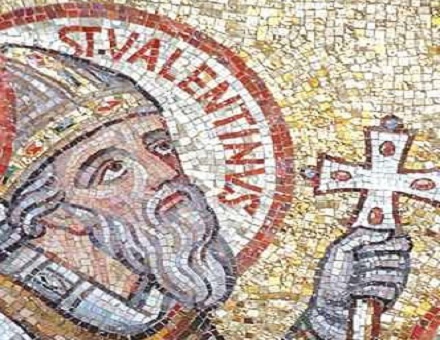Who was St Valentine?

St Valentine’s Day is a day to celebrate romantic love, perhaps with a meal out, with presents of chocolate or flowers and, of course, with a card. It is the second largest card sending occasion of the year after Christmas.
Who was St Valentine?
St Valentine of Rome was a Christian Priest, who was martyred on February 14th 269 AD .In 496 Pope Gelasius declared that his feast would be celebrated on 14th February.
Facts about his life are few, and like many other legendary figures, the story has been embellished over the years. It seems likely that accounts of his life were destroyed during a later large-scale persecution of Christians. Valentine (or Valentinus) was a common name in Roman times, and there are a dozen Saint Valentines. One of the other Saint Valentines – Valentine of Terni – was martyred four years later and also celebrated on 14th February. This has caused confusion, and stories of the two saints may have merged together.
We know that he was a practising priest and that he was martyred by being stoned and then beheaded.
There is a story that the Emperor Claudius II banned marriages because he thought that married men made poor soldiers, and he needed more fighters for his campaigns against the Goths. The story goes that Valentine continued to carry out marriage ceremonies in secret. This story seems to have been added later to associate Valentine more closely with romantic love.
It was also stated, and repeated during the early period of Christianity, that Valentine was personally questioned by the Emperor and tried to convert him to Christianity.
Condemned to death, Valentine was placed in the custody of his jailer Asterius.
Prisons in ancient Rome were very basic, and only used as short term holding areas for people awaiting trial or execution. A few people of rank were spared from the prison and remained instead under house arrest or, like Valentine, at the homes of a jailer.
St Valentine’s miracle was to heal the daughter of Asterius, named Julia, from blindness. A later addition to the story suggests that on the eve of his execution, Valentine left Julia a card signed “Your Valentine”.
Celebrations
There are claims that as far back as Anglo Saxon times, young men would leave gifts for women outside their doors on St Valentine’s Day. However this was probably linked to an older pagan celebration of love.
The first link between St Valentine and romantic love was in Chaucer’s poem Parliament of Fowls (birds),written in 1382 to celebrate the engagement of Richard II of England, though it is possible that he was actually referring to a different saint – Valentine of Genoa!
It is thought that in late Medieval times, men would draw lots to decide who their valentine would be, then place the name on their sleeve for one week, giving rise to the expression “wear your heart on your sleeve”.
Valentine’s Day is mentioned in Shakespeare’s Othello, and by the 17th century poet John Donne. There are records of Valentine cards from the 17th century, but it was the growth of the postal service in Victorian times that enabled the custom to become widespread.
The tradition of sending cards anonymously stems from this period. Male senders did not want to antagonise the fathers of their valentines during these prudish times.
Cadbury were producing chocolate hearts over 150 years ago.
Valentines Day was originally celebrated in Britain, and the English speaking world.
Is St Valentines Day still a religious festival?
The Catholic church removed St Valentine’s Day from its calendar because not enough is known about the life of St Valentine. But it remains on the calendars of the Lutheran churches and the Church of England.
Valentine Cards
Valentine Cards from Card Shack
Valentine Cards from Creased Cards

